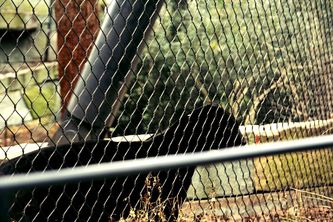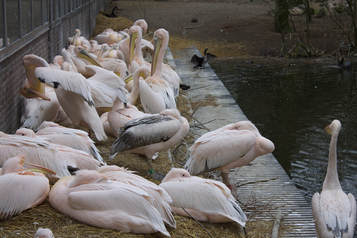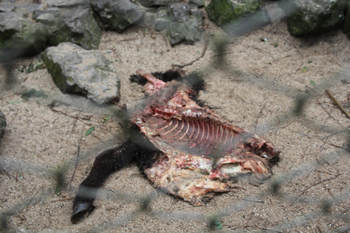Thick descriptions
Why Smell the Zoo?
By Chihhen Chang.
The visit to Artis Royal zoo is, unsurprisingly, a disappointing experience. The lethargy of displayed animals and their inurement to disturbing zoo visitors like me, who always anticipate more from them, evoke bad feelings, a phenomenon art critic John Berger convincingly interprets in his influential essay, “Why Look at Animals”. He starts with a lament about zoo animals deprived of their wildness and reduced to a “spectacle” which is meant to entertain but always fails to satisfy the zoo visitors, since they are made unable or perhaps unwilling to look back, to respond to our desperate gaze. Berger concludes that the zoo animals “have been immunized to encounter” and turned into a “living monument of their own disappearance” (24). The lack of meaningful human-animal interaction in the zoo only reminds people of their absence, their disappearance from our live.
Berger’s insights, indeed, are compelling and resonating. His critique of zoo, according to Lisa Uddin, becomes “a staple of contemporary zoo criticism” (2). For me personally, staring at the encaged jaguar, petrified into a statue by boredom and always looking across me into the void, provokes no sense of real encounter but depression and guilt. However, to look at the vocabularies he uses, his emphases on the “visibility,” “gaze,” and the spectacularization of animals ignore other sensory experiences we might encounter in the zoo. It is not so surprising that the later zoo criticism follows this privilege of sight, focusing on the issues of “vision,” “representation,” and “visibility” in the zoo.
While there are very few scholar works on sensory experiences like smell, touch, and sound in the zoo, it seems that its visitors also overlook these experiences. One may argue that the zoo is about “displaying” the animals, and hence our chance to use other senses in the zoo is relatively limited. Normally, we are not allowed to pet the animals on display, and this is also the case for Artis Royal Zoo. During the visit, a child was warned against touching a lemur, which luckily was not enclosed, roaming around their feeders. And of course, it is quite unlikely to taste the zoo animals, though the visitor always has a chance to wolf down a bacon bagel in the zoo cafeteria after watching animals—the zoo is good at offering feasts for both the mouth and the eyes.  Hearing probably can be a good topic, but my interest lies in smelling, a sense which is associated with animals and regarded as inferior to “sight” as means of “discovery and knowledge” after the Enlightenment era (Classen, Howes, & Synnott 84). Whether focusing on the olfactory experiences can help us avoid the problematic division between subject(human)/object(animal) implicit in the “observing” as a mode of knowing, it is sure that this re-orientation allows for a different way of addressing the issue of bad feelings in the zoo.
Hearing probably can be a good topic, but my interest lies in smelling, a sense which is associated with animals and regarded as inferior to “sight” as means of “discovery and knowledge” after the Enlightenment era (Classen, Howes, & Synnott 84). Whether focusing on the olfactory experiences can help us avoid the problematic division between subject(human)/object(animal) implicit in the “observing” as a mode of knowing, it is sure that this re-orientation allows for a different way of addressing the issue of bad feelings in the zoo.
Zoo and the Urban Smellscape
The smell of the animals in the zoo is something one can hardly escape once entering the zoo, unless one decides to stay in the zoo restaurant or the planetarium all day long. J. Douglas Porteous’s concept of “smellscape” suggests that smells can be “spatially ordered or place-related,” like visual impressions (359). From this point of view, the Artis Royal zoo can be roughly divided into two types of space: space reeked with the animal’s body odor, mixed with the smells of their living surroundings, food, and waste combined, and the sanitized space where the animal’s smells are hardly detectable.
The deodorization and the control of smell in the zoo, which determines the presence or absence of animal smells in certain areas, can be associated with the broader context of human’s attempt to control and refine the smell of the urban space, and it also explains the high concentration of animals’ smell in a few areas, like zoo, in the city. In the European context, the purge of animal smells from the urban space couples with its sanitization during the nineteenth-century. One of the primary goals of the urban sanitary reform is to remove the bad smells, misidentified as the cause of epidemics like cholera and typhus and believed to be harmful to morality, among them including the smell relating to animals. Physician John Hogg, an enthusiastic proponent of the sanitary reform, complained about the existence of slaughterhouse in the city, a place gives off the stenches of animal wastes, corpse, and, figuratively, their pain:
“Whole trains of coaches, omnibuses, and wagons, are stopped by bullocks and sheep…often do the poor animals, overheated, and faint with thirst, rush towards a gutter of liquid filth, and drain it of its black and putrid contents, often do they drop and die in the streets from ill-usage and exhaustion, and frequently are they crushed and destroyed by the wheels of heavy-laden vehicles, and so the butcher’s knife is cheated of its victim!” (220)
At the same time, the upper-middle class family sprays their animal pets with floral herbal perfume, which has replaced perfume with the origin of animals such as musk and civet by the late eighteenth century (Classen, Howes, & Synnott 73). The smells of animals were gradually marginalized, if not totally eliminated, in the urban space. In the end, zoo, as a part of urban smellscape, become one of the few places people can still smell animals.
Encountering through Smell: Animal Smells and Bad Feelings
Upon entering Artis Royal zoo, I was greeted by various smells issuing from the displayed animals, the diverse olfactory nature of which I cannot fully capture using my limited vocabulary. I can barely begin to fully comprehend what these smells mean to the zoo’s non-human inhabitants. Do they use their odor to communicate with each other? Do they feel unease about the smells of their neighbors of other species? As a human being, with less heightened olfactory faculties, I started to do what I am better at—generalizing and categorizing. In general, the different areas and enclosures in the Artis Royal zoo are characterized by distinct odors, varying according to its inhabitants. The enclosures of small water mammals such as otters perhaps are the most smell-less, while the enclosure of flamingos is featured by extremely strong and almost repulsive fishy odor. The smell of animal waste issuing from the enclosure of herbivores like giraffes, antelopes, and elephants, can reach the visitor around ten meters away from it, while the area around the enclosure of large carnivore like jaguars or lions, believed to have the excrement that smells more stinky than that of herbivores, are almost smell-less, probably because there are fewer individuals in the enclosure. The density matters: the more animals are kept in a confined area, the stronger the smell is.
 Encountering these smell of animals in the zoo sometimes can be an unpleasant experience for some. At least for me, the olfactory encounter triggered a “search of lost time” which I would rather forget, reminding me of my childhood visit to Taipei zoo, where I was traumatized by the odor of the steaming donkey-dung in the heat. Anyway, whether the smell is “memory releasers,” to borrow Porteous’ phrase again, that reconstructs one’s past or childhood (357), for many visitors these animalistic smells are simply un-agreeable, too strong and too stimulant to our well-protected noses, which are more used to the sanitized air of the city. From this perspective, their pervasive smell ridicules human’s will of total control over the animal’s body in the zoo. While the zoo can decide the way in which the animals are displayed in order to attract the visitors, the cost would be too high to purge the odor off and to control the way in which the zoo animals smell. Romantically speaking, the pungent smell can be viewed as part of their resistance, a protest against their fate of being captivated and forced to perform in the artificial enclosure.
Encountering these smell of animals in the zoo sometimes can be an unpleasant experience for some. At least for me, the olfactory encounter triggered a “search of lost time” which I would rather forget, reminding me of my childhood visit to Taipei zoo, where I was traumatized by the odor of the steaming donkey-dung in the heat. Anyway, whether the smell is “memory releasers,” to borrow Porteous’ phrase again, that reconstructs one’s past or childhood (357), for many visitors these animalistic smells are simply un-agreeable, too strong and too stimulant to our well-protected noses, which are more used to the sanitized air of the city. From this perspective, their pervasive smell ridicules human’s will of total control over the animal’s body in the zoo. While the zoo can decide the way in which the animals are displayed in order to attract the visitors, the cost would be too high to purge the odor off and to control the way in which the zoo animals smell. Romantically speaking, the pungent smell can be viewed as part of their resistance, a protest against their fate of being captivated and forced to perform in the artificial enclosure.
 However, although it is quite “natural” for the zoo animals to give off their distinct odors, the odor-saturated environment of the zoo is far from being natural. The strong, pervasive smell of animals in the zoo points only to the human-made concentration or even the over-population of animals in a confined space. It also underlines the sad truth of their displacement from the natural habitat, the place where they are supposed to leave these smells. Some functions of their smells, like attracting mates or marking their territory, become useless in the artificial habitat. Mating becomes a matter of bio-political management in the zoo, as Matthew Chrulew elaborates in his “Managing Love and Death at the Zoo: The Biopolitics of Endangered Species Preservation”. These scents end up in the nostrils of human visitors, who may cover their nose, frowning, and making a brief remark on how stinky it is, which is my first reaction to it. Fortunately, I was spared from the stench of decomposing animal bodies. There is no smell of death in the zoo; it usually takes place in the invisible space and emerges in its incomplete, belated form. I saw a processed carcass part used as food in the vulture enclosure, but its smell was too slight to be sensed by me personally. In the end, I remained ignorant of the identity of the mysterious carcass. I don’t know whether it is from a “surplus animal”, who are too old, unprofitable, or simply do not fit in the breeding program of the zoo, or just a random animal from a random slaughterhouse. Moving from one enclosure to another, I was thinking of the futility of reproducing in the zoo, of marking the territory which does not belong to them. The smell reminds me of not only their presence but also their out-of-place existence.
However, although it is quite “natural” for the zoo animals to give off their distinct odors, the odor-saturated environment of the zoo is far from being natural. The strong, pervasive smell of animals in the zoo points only to the human-made concentration or even the over-population of animals in a confined space. It also underlines the sad truth of their displacement from the natural habitat, the place where they are supposed to leave these smells. Some functions of their smells, like attracting mates or marking their territory, become useless in the artificial habitat. Mating becomes a matter of bio-political management in the zoo, as Matthew Chrulew elaborates in his “Managing Love and Death at the Zoo: The Biopolitics of Endangered Species Preservation”. These scents end up in the nostrils of human visitors, who may cover their nose, frowning, and making a brief remark on how stinky it is, which is my first reaction to it. Fortunately, I was spared from the stench of decomposing animal bodies. There is no smell of death in the zoo; it usually takes place in the invisible space and emerges in its incomplete, belated form. I saw a processed carcass part used as food in the vulture enclosure, but its smell was too slight to be sensed by me personally. In the end, I remained ignorant of the identity of the mysterious carcass. I don’t know whether it is from a “surplus animal”, who are too old, unprofitable, or simply do not fit in the breeding program of the zoo, or just a random animal from a random slaughterhouse. Moving from one enclosure to another, I was thinking of the futility of reproducing in the zoo, of marking the territory which does not belong to them. The smell reminds me of not only their presence but also their out-of-place existence.
Returning to the issue of feeling bad in the zoo, what can we think about the relation between the bad zoo feeling and the animal’s smell? Did I feel unpleasant simply because the animals stink? Or should I do so? During the visit, what struck me the most is the smell of the gorilla enclosure located inside a building. The place, characterized by the damp, mixing smells of straw and the gorillas’ odor, seems to need improved air-circulation. Interestingly, no visitor complained about the odor. A middle-aged lady was drawing a gorilla, which looks like a melancholic philosopher in my eyes, with her pen. Two children screamed at the hyperactive adolescent gorillas playing with each other, and their father looked at them with an impassive expression. “Is the smell bearable for them? Do they simply take it for granted and ignore it? Or do they, like me, also think about how suffocating the smell is and want to leave as soon as possible?” I asked myself. Shamefully, how the non-human inhabitants feel is the last question to come to my mind. After a few minutes of walking, the smell is not as unbearable as the moment when I initially entered the building. It seems that the olfactory fatigue begins to set in, helping me to get adapted to the bad smell. Perhaps it is also the case of other visitors—getting used to other’s smell and their sufferings. As a human being with the privilege to move more freely and to escape from what makes me feel unpleasant in the zoo, I perhaps should neglect my own discomfort, and start to look at and to sense the unpleasantness of the living conditions of the captivated animals—to turn this olfactory encounter with animals into an ethical one.
Works Cited
Berger, John. “Why Look at Animals?” About Looking. London: Writers and Readers Publishing Cooperative, 1980, pp, 1–26.
Chrulew Matthew. “Managing Love and Death at the Zoo: The Biopolitics of Endangered Species Preservation.” Unloved Others: Death of the Disregarded in the Time of Extinctions, Australian Humanities Review 50, ed. Deborah Bird Rose and Thom van Dooren, 2011.
Classen, Constance, Howes, David, Synnott, Anthony Aroma: The cultural history of smell. London: Routledge, 1994.
Hogg, John. London as It Is. London: John Macrone, 1837.
Porteous, J. Douglas. “Smellscape.” Landscapes of the Mind: Worlds of Sense and Metaphor.
Toronto: University of Toronto Press, 1990, pp. 356-378.
Uddin, Lisa. “Introduction.” Zoo Renewal: White Flight and the Animal Ghetto. Minneapolis: University of Minnesota Press, 2015, pp. 1–25.

